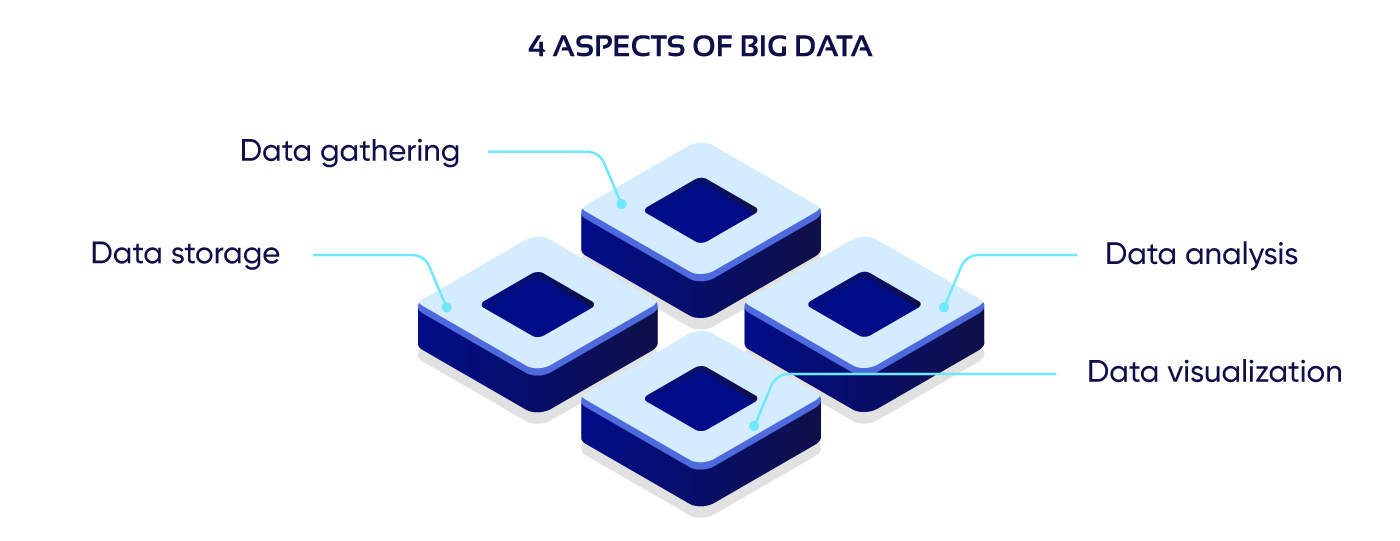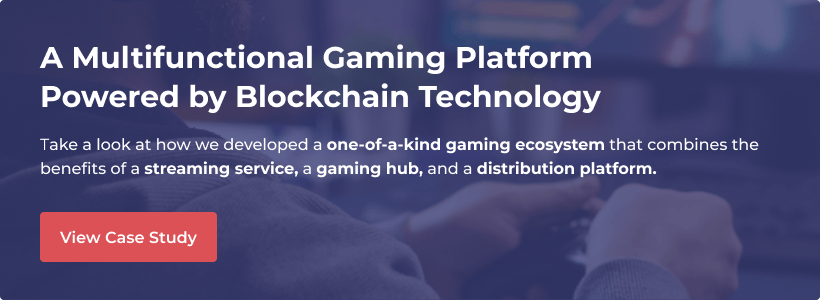Big Data is among the hottest trends in Data Science nowadays, yet the concept of this notion may be difficult to understand due to its vagueness. Indeed, how big the data must be to be identified as, well, “Big?” Spoiler alert: you won’t find a definite answer with a precise number anywhere. Still, the inexplicit definition does not hinder the extensive use of Big Data in business.
Impact of Big Data on Business
The concept of Big Data refers to indefinitely large volumes of information, both raw and processed, obtained from various sources and used by companies for some beneficial effect. Since it is impossible to provide a more precise definition, let us focus on another popular question: “how is Big Data used in business?”
The advantageous effect of employing Big Data for business depends on numerous factors, most importantly – on the business type. In general, it is used to promote products, develop better business strategies, reach customers, explore new markets and target audiences, optimize workflow, lower costs, and gain other competitive advantages on the market. The ultimate business impact of Big Data, regardless of the specific field of its implementation, is raising profits through data collection, processing, and utilizing analyzed information.
However, it is important to understand that Big Data alone may be insufficient for obtaining sizeable long-lasting benefits and that it provides much better results in combination with AI, ML, cloud services, and other powerful Data Science solutions. For the sake of a more detailed description and to get a better understanding of how this technology influences business processes, let us review several relevant industries that benefit from Big Data.

Retail, Marketing, and Advertising
Retail companies are among the largest consumers of Big Data solutions as they deal with staggering amounts of data on a daily basis. Both offline distribution networks and online marketplaces collect and process large volumes of information in order to use it later for management, marketing, and other business intelligence activities.
The sources of such information vary depending on the enterprise type and may be quite numerous and diverse. They include, among others, cookie files, especially those related to social media, POS terminals, customer surveys, and other means to collect information on user behavior.
The most frequent task of Big Data solutions is linked to finding behavioral patterns that can be employed for many purposes. Understanding the habits and desires of customers is the primary concern of any business, and Big Data analytics is the only valid way to achieve precise results based on large sampling and extensive calculations instead of personal hunch and experience.
Another common application of Big Data in business is forecasting performed using predictive analytics on the basis of large data sets. The bigger number and volume of data sets allow obtaining more precise results, configuring more parameters before the analysis, and even extending the topics and overall possibilities of forecasting. One of the most prominent examples of such automated prediction solutions is called MemeMachine, and it is employed specifically for advertising. In particular, it helps to increase the effectiveness of ad campaigns by providing valuable strategic advice based on input parameters and the assembled database of customer behavior patterns. As a result, this solution allows saving budget regardless of the advertising type and platform: Google Ads, AdMob, Brandvoice paid program, and so on.
Banking and Finance
Financial institutions do whatever they could to minimize risks; that’s why they need to check a lot of information, in addition to other activities that involve data handling. Therefore, they employ Big Data solutions to collect extensive data about their clients that covers the financial history and other behavioral aspects. Analyzing this data allows financial institutions to decide whether they should give a credit to a particular client or to realize what kind of deals and services are required by customers.
Moreover, the use of Big Data techniques allows banks to implement sophisticated risk management systems that offer fast risk calculation enhanced by artificial intelligence and machine learning. These complex systems provide analysis results shortly after they receive input data, so the client waiting time is reduced significantly. As a result, the clients learn the decisions regarding their loan applications almost immediately.
Since the banking industry is characterised by high risks and even higher competitiveness, Big Data software provides invaluable advantages here. However, to use Big Data with maximum efficiency, a company should also invest in the infrastructure that provides an appropriate level of computational power, storage capacity, data throughput, and security.
One illustrative example of using Big Data for the purposes of credit companies and banks is described in our case called “AI Loan Finance.” This solution retrieves and analyzes information on the client's credit history and security property in order to decide whether a person should receive a loan. The software uses several national-wide databases and may operate in a fully automated fashion after receiving input data.
Resource mining industry
Many large companies that engage in mining and extracting natural resources, primarily gas, oil, or coal, benefit from implementing Big Data technologies in their businesses. Such industries involve a number of activities that require careful management with an extremely high precision level. The scope of resource extraction companies is usually very large, and they may include dozens of mines, rigs, and other platforms for collecting natural resources. Therefore, the operation of such companies results in immense data flows that require significant computational power in order to collect, process, and store such amounts of information.
Mining companies often use Big Data to plan their expansion strategy in terms of searching for new producing areas, field development, and reservoir exploitation. Thus, resource mining is among the few industries that use large amounts of data for production forecasting. This research is crucial in this field as it saves significant amounts of time and money that would otherwise be wasted on drilling dead ground or excavating barren rock. With the help of AI and ML, raw data is compared with the existing databases to calculate the economic feasibility of developing the specific resource production region using geological data, fuel price fluctuations, weather forecasts, and other crucial factors.
As another example, Shell implements Big Data solutions in combination with AI technologies and cloud services to analyze its immense machinery stock, predict its wear over time, and plan the maintenance and ordering of new parts and appliances. This approach allows maintaining the steady workflow, minimizing downtime caused by equipment fails, and optimizing the inventory of spare parts. All these benefits result in considerable savings of money and time, and improve productivity leading to better profits.
At last, it should be noted that most mining enterprises also engage in retail and transportation activities that are described herein as separate industries. This way, most benefits described in relation to those industries are also relevant for resource mining.
Transportation and Logistics
Like other enterprises mentioned in this article, transportation companies also deal with large volumes of information regarding vehicles, passengers, luggage, and cargo. The necessity to manage extensive data flows under tight time constraints imposed by transport schedules requires high-performance software solutions designed specifically for Big Data.
The practical purpose of such solutions lies in tracking cargo delivery, monitoring fuel usage and supply, the technical condition of the company’s vehicle park, drivers’ health checkups and work schedule, as well as many other relevant factors. This way, companies can use Big Data software to prioritize safety in addition to the usual resource consumption optimization and effectiveness improvement.
Other business system management
The examples presented above described the industries where the use of Big Data has already become a customary technique that increases business effectiveness. However, in addition to the aforementioned fields, Big Data may be effectively used in many other business areas. In fact, any enterprise that requires business insights and powerful resource monitoring options, as well as many other management features, will benefit from this technology.
Due to the high applicability of Big Data solutions, the demand on them is gradually rising every year across various industies. Business analysts predict that the revenues from the global Big Data market will reach 70 billion dollars in 2020 and about 103 billion dollars in 2027.
4 Aspects of Big Data Required for Business
Due to the large scope of demanded features, Big Data solutions require extensive hardware resources that must be combined into a well-synchronized infrastructure. Regardless of the particular industry, the software that handles Big Data has high specifications regarding processing units, storage, RAM, and other computer system components in order to be efficient. The insufficient performance of any component can easily lead to the “bottleneck” effect that impairs the operation of the whole infrastructure, so the Big Data system must be well-balanced. The combined power of those components is used for the following data management needs:
Data gathering
Collecting user data is the first step in the operation of Big Data systems. There are numerous ways to obtain user data, and most of them are performed without explicit participation, or even knowledge, of users. While customers may knowingly provide some personal data via surveys or feedback forms, for example, the great bulk of information comes from cookie files and other web trackers, as well as telemetry services and IoT devices. This unprocessed data is of limited use, but after the subsequent analysis step, it becomes invaluable for both young and established enterprises. The analyzed information enables building effective marketing strategies, among other business development activities, that will be discussed below.
Data storage
Big Data solutions have extremely high requirements for information storage capabilities as they have to store both collected raw data and processed data. The bigger the client base is, the more storage space must be provided by the business company. The whole bulk of information may be kept on hard disk drives on the company’s premises, or the company may use cloud solutions to store its data in remote data centers. Today, even the largest companies tend to rely on cloud service providers in terms of keeping their data as safely and securely as possible. However, in view of possible international sanctions or security concerns, local storage on the company’s hardware may be preferable.
Data analysis
In order to make use of collected data, it must be subjected to comprehensive processing that consumes significant computational resources. Big Data processing is a very extensive activity that comprises several tasks, such as raw data conditioning that includes duplicate removal and the subsequent comprehensive analysis. Depending on the available capabilities, single-thread and multi-thread processing is performed on the bulk of collected information to classify and categorize it in order to enable easy search and filtering. After these processing steps, the data is ready for further use by AI or ML components to provide prediction results.
Data visualization
In this context, visualization may be applied to both categorized data accumulated in the database, and the analysis results obtained using this information as a source. The structured information stored in databases is better displayed by the conventional means designed for statistical data, such as graphs, pie charts, etc. The visualization of analysis results may vary to a great extent as they mostly refer to probability chances. For this reason, they may be presented in similar forms of charts and graphs as mentioned above or in the form of a single definite answer, enumeration of possible variants, tier lists, etc.
Conclusion
Whether your business is big or small, there is always a way to benefit from Big Data solutions. The most important advantage offered by this technology is the knowledge of clients’ needs and behavior patterns. This information, coupled with high-precision forecasting also offered by Big Data, allows entrepreneurs to devise effective business strategies instead of wasting time and money on the try-and-error method. The ability to handle large volumes of information using automated software solutions also greatly simplifies enterprise management, including such aspects as maintenance, inventory, shipping, workload, and others.
If you want to employ Big Data software and use its powerful capabilities to benefit your business, contact us. We have great expertise in this field and will provide you an effective solution customized specifically for your needs.




